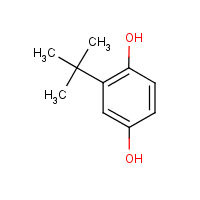t-Butylhydroquinone
Agent Name
t-Butylhydroquinone
Alternative Name
TBHQ
CAS Number
1948-33-0
Formula
C10-H14-O2
Major Category
Other Classes

Synonyms
1,4-Benzenediol (1,1-dimethylethyl)-; 1,4-Benzenediol, 2-(1,1-dimethylethyl)-; 2-(1,1-Dimethylethyl)-1,4-benzenediol; 2-t-Butylhydroquinone; 2-tert-Butyl(1,4)hydroquinone; 2-tert-Butyl-1,4-benzenediol; 2-tert-Butylhydroquinone; Banox 20BA; Hydroquinone, t-butyl-; Hydroquinone, tert-butyl-; MTBHQ; Mono-tert-butylhydroquinone; Mono-tertiarybutylhydroquinone; Sustane; TBHQ; Tenox TBHQ; t-Butyl hydroquinone; tert-Butyl-1,4-benzenediol; tert-Butylhydrochinone\r\n; tert-Butylhydroquinone; tertiary-Butylhydroquinone; Butylhydroquinone, tert-; [ChemIDplus] UN3077
Category
Phenols
Description
White to light tan solid; [HSDB] Tan powder; [MSDSonline]
Sources/Uses
Used as antioxidant for fats and oils (approved for use in foods); [HSDB] Used at concentrations of 0.1 to 1.0% in cosmetics; Also used to prevent rancidity in food at concentrations of 0.02%; [REPROTOX]
Comments
Causes ataxia in inhalation studies and changes in liver weight in feeding studies of laboratory animals; [RTECS] Not likely to be embryotoxic in humans based on studies of rats exposed to 0.5% in the diet; [REPROTOX] A skin and eye irritant; [CAMEO] Skin sensitization has been reported in cosmetics and cutting oils; [Kanerva, p. 1763] An irritant; [MSDSonline] See "Hydroquinone."
Biomedical References
Exposure Assessment
Lethal Concentration
LCLo (rat) = 2,900 mg/m3/4h
Explanatory Notes
The Guide in the Emergency Response Guidebook is for "Environmentally hazardous substances, solid, n.o.s."
Adverse Effects
Skin Sensitizer
Yes
Diseases, Processes, and Activities Linked to This Agent
Diseases
Occupational diseases associated with exposure to this agent:
Processes
Industrial Processes with risk of exposure: